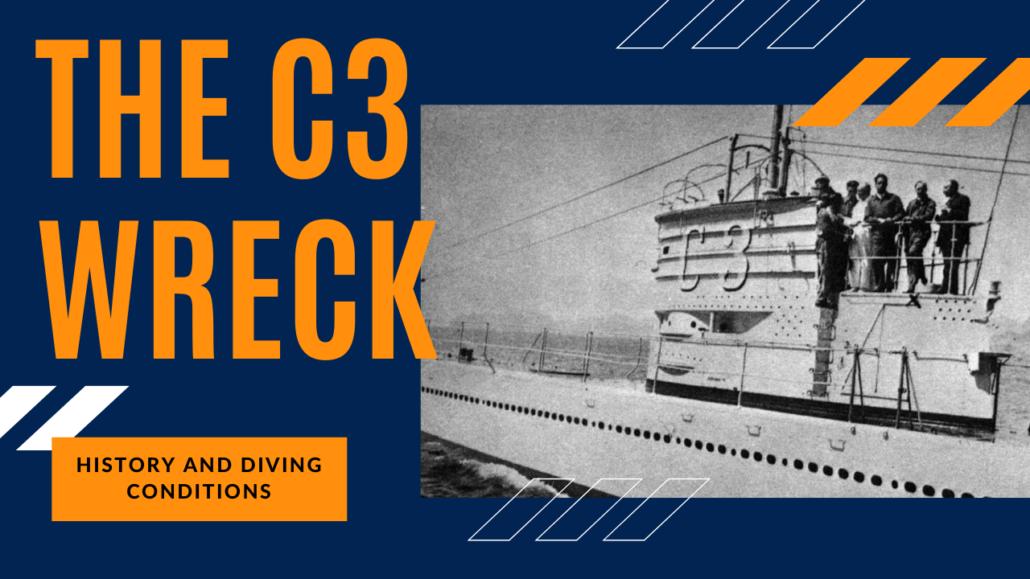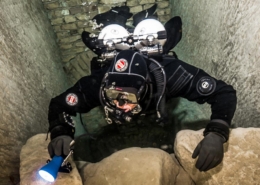The C3 Wreck: History and Diving Conditions
By Samuel Segura Menchen
The C3 was torpedoed and sunk by a Nazi submarine in front of the Málaga coast on December 12th of 1936. She was a Spanish Republican submarine, sunk during the Spanish Civil War. Only 3 crew members survived.
The C3’s first role was to patrol the coast and protect it from bombings, but its condition was not optimal, as one of her engines had problems caused by depth charges released by rebel ships in the Cantabric sea.
Captained by Lieutenant D. Antonio Arbona Pastor and with 40 men aboard, the C3 managed to get to Málaga with speed limitations and battery charging problems. One of their last days’ orders was to serve as a lookout staying at the surface in front of the coast of Málaga, should the Rebel Canarias cruise appear. The crew could not believe that they were ordered to keep the submarine surfaced. They felt this made them a perfect target, but during that morning, the C3 patrolled the entrance of the city harbor.
The U34, a German U-Boat returning to Germany, raised its periscope and found the C3. They launched a torpedo and struck, sending the C3 70 meters deep. The sinking was seen by many aboard the ships anchored in the vicinity and was even seen from land. The citizens witnessed a big explosion and the following sinking. Local fishermen have always known the location of the sunk Republican submarine, although sometimes memory becomes a little “picky” in the desire to turn pages and forget the event.
How deep, what cert, and where?
However, this precise historic chapter of the C3 is somewhat different. The crew’s relatives have not forgotten them, and they have been claiming the remains of their ancestors from long ago. They have even proposed the idea of a possible refloating of the submarine, a subject which has become increasingly popular. There are few other chances to dive a submarine wreck in Spain. That said, we feel very lucky to have it in a reasonable depth that allows us to make a dive within the range of the TDI Advanced Trimix diver certification. It is a medium to high difficulty dive, if I had to rate it, and is off-limits of recreational diving certifications. It is located between 67 to 70 meters deep and there are areas full of ropes and nets, becoming a potentially deadly trap.
What can I do to get down there?
This is one of our trainees’ more common questions. In our center, we offer all levels of TDI training and we strive every day to give our students a solid and structured base in technical diving. We train the divers, giving them the ideal formation for the environment they are going to dive in. We also have shared dives with certified divers and underwater explorers from other countries, working with both Open Circuit and Rebreather systems.
Diving the C3
In this case, to dive in the C3 is to dive into the Spanish Civil War. The anchoring maneuver is a bit trickier than in other wrecks, as the hull is a cylinder and it does not raise much from the bottom. It amazes us to see, while we are equipping in our boats, the fuel droplets that still emerge from the wreck They are a reminder of those who lost their lives in the C3 more than 84 years ago.
Usually, we work with hypoxic trimix for the dive and high oxygen concentration gasses for decompression.
For this dive we recommend using the primary spool, as the visibility can be low and we can miss the anchor line. The wreck sits in navigation position on the seabed. The hull is broken, with a portion that remains few meters away from the main structure.
As you arrive, you can distinguish a big cylindrical structure lying on the bottom. Nowadays, the corrosion has deteriorated the hull and the submarine tanks. Slowly, you start to recognize a different structure – how a submarine looks, the hatches, the torpedo launchers, the sail… We start making a tour until we find the sail that raises a few meters above the main structure. Limestone layers cover the place where its identification number and its name was located. Just before the sail is where the cannon was placed. We have been looking for it on many dives, but have had no luck.
In some areas, as the rusty planks of the hull start to decompose, they are leaving the structural reinforcements on view. The pressure tube’s reinforcements can be seen. We reach the breach in the hull. This might be where the explosion occurred. There is still half of the dive remaining for us to finish exploring the deck area.
There, in the breach, is where we find a possible entry point to the pressure tube. We can distinguish instrumentation remains and part of the sub’s machinery. Fabric, clothing, cables, springs, and seats can be found. There is more exploration to be done in this area.
This is a tricky area as we found a fishing net covering half of the cylinder, in which we could get entangled. There is more specific training to be done inland. That way, we could be able to penetrate the wreck and keep making discoveries. We follow one of the ship’s sides as we return to the anchor line, the ascent point. We start to see holes in the outside layer, allowing us to see through different parts. We can clearly distinguish valves, piping, handrails, batteries, cables…
The moment to start the ascent has come, as you start to think about everything you have seen and start replaying it inside your head, you realize that you have dived beside military sailors that lost their lives and are still inside the C3. Then, your only thought is to come back to the surface again and to bring great videos and pics of that day in which you dived a part of the history.















Leave a Reply
Want to join the discussion?Feel free to contribute!